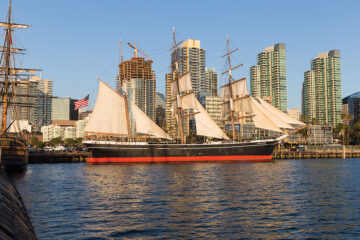San Diego Museum of Art thrives under the direction of Roxana Velásquez
Velásquez has seen museums transform themselves from staid, temple-like repositories into hubs of activity that attract and actively engage members of the community.s

In the not too distant past the thought of visiting a museum, especially an art museum, might conjure images of silent galleries and small placards carrying little more than the name of the artist and the year in which the work was created. Traditionally, museums saw their mission as one of collecting and preserving art, not so much as one of how best to share the remarkable treasures they had amassed.
“It was all about the art and artist. Now we are just as concerned with the viewer’s experience,” explains Roxana Velásquez, the Maruja Baldwin Executive Director of the San Diego Museum Art.
What Velásquez is referring to is the shift over the last two to three decades that has seen museums transform themselves from staid, temple-like repositories into hubs of activity that attract and actively engage members of the community.
For Velásquez, who sees “the beauty and intelligence of art as a common language” transcending time and culture, it is a welcome development, and central to her leadership at the museum.
Velásquez arrived at the museum in 2010 and her list of accomplishments in the nine years since is impressive to say the least. Recognizing the power of art to bring people together, Velazquez and her team have not only elevated the museum’s stature in the United States and around the world, they have worked hard to break down barriers that restricted access in the past.
Over the last three years, the number of visitors to the museum has increased by 90 percent — a testament to the museum’s community involvement — and in this, SDMA is also extremely blessed in its location. Flanked by the Timken Museum to the east and its own Panama 66 café to the west, SDMA anchors the north end of the Plaza de Panama, one of Balboa Park’s great spaces, which itself has undergone substantial change in recent years. Where there were once cars and parking spots, there are now tables and chairs, making it once again the gathering place it was intended to be, and likely one that will be further enhanced in the future.
For the moment, thanks to an agreement between the museum and the city, it is also home to several large, outdoor sculptures from the museum’s permanent collection, installed in a project known as “Free the Art.” Some were concerned people might damage the works, but Velazquez had no such fear. “In all my years, I never had any problems. I find people respect art,” she says, referring to similar installations at the Museo Nacional de San Carlos, the Museo Nacional de Arte (MUNAL), and the Museo del Palacio de Bellas Artes in Mexico City, museums where she previously served as director.
It is an understanding that fits well with her view of art as a universal language, and a good example of breaking down barriers when it comes to viewing art — as is her hard-fought battle to make the museum free for people under 17.
At the same time, using new and innovative display techniques the museum’s Visible Vault exhibit provides ongoing access to some of the collection’s most fragile masterworks, those on paper. In the past, works on paper were stored twelve months for every month they were on display, meaning years could go by between viewings.
Velazquez’s love of art is immediately apparent, as is her belief in its ability to unite people in understanding and insight. That is the reason to engage the community, especially one as diverse as San Diego, and to help in that effort, the museum offers the public many options. There are extended hours on Friday nights, while on Wednesday nights trumpeter and composer Gilbert Castellanos presents the Young Lions and Jazz Jam series in the James S. Copley Auditorium or May S. Marcy Sculpture Court next Panama 66.
There are also Culture & Cocktails events as well as films, lectures, symposiums, and even dance performances associated with its exhibits — everything designed to engage the viewer and provide greater context.
The Art
Still, for an art museum, in the end it comes down to the art, and as Velazquez is proud to point out, at its core SDMA has one of the finest collections of Spanish masters outside of Spain — a collection that now includes four works by Francisco de Zurbaran, the most of any museum in the United States.
Like many of the museums in the park, SDMA got its start during the great California-Panama Exposition of 1915. San Diego was announcing its arrival as both a major port and cultural center, and among the numerous exhibits was a fine arts display featuring both old European masters and American artists. It was that exhibit that eventually led to the museum we know today and it was the old European masters that signaled culture.
Indeed, while the design of what was originally called the Fine Arts Gallery of San Diego was inspired by the Spanish-Colonial style featured in the exposition buildings, the permanent museum did not open its doors until 1926 and the architect William Templeton Johnson took it a step further, looking directly to 16th century Spanish Renaissance models. Employing a style known as plateresque for its rich ornamentation suggestive of silver work, the museum’s exterior borrows motifs from the Cathedral of Valladolid and the University of Salamanca. The grand façade, recently restored to its original brilliance, also includes life-sized sculptures of the great Spanish masters Velázquez, Murillo, and Zurbarán, as well as references to El Greco and Ribera — all five of whose works were displayed together for the first time in the museum’s history during the Art & Empire exhibition.
Art & Empire, which is now on its way to Monterrey, Mexico, is truly awe-inspiring and an excellent example of the extraordinary work Velazquez and her team are doing. More than four years in the making, the exhibition features an astonishing array of paintings, sculptures, books, tapestries, and other items from the Spanish Golden Age.
Building on one of the museum’s strengths, Spanish masters, Art & Empire brings together some two and half centuries of art from around the globe — from Spain and the Spanish Netherlands in Europe to Spain’s vast provinces in North America, South America, and Asia. In keeping with Velazquez’s view of art as a language that transcends time and culture, the artists represented in the exhibit can be seen working with ideas of old and new, modern and primitive, likeness and difference where such interactions were taking place in real time with consequences that continue to shape the world today.
In that way, Art & Empire is a show not only with great relevance for San Diego and the United States, but one with great relevance for many cities and countries as Velazquez intended.
The response to the show in San Diego was extraordinary as art lovers and experts travelled from afar to view, discuss, and lecture on the show, an indication of SDMA’s growing stature, as is the fact that so many museums were willing to lend their precious works, some of which had never before been on view in the United States or not for many decades.
Art & Empire is precisely the kind of world-class exhibit we can expect from Velazquez and her team, and Spanish masters are not SDMA’s only strong suit. Velazquez is quick to highlight the museum’s other strengths including major collections of German expressionism, Southeast Asian art, and works by the French artist Toulouse-Lautrec. In fact, in the spirit of breaking down barriers and sharing one’s treasures, the Edwin Binney 3rd Collection of Indian paintings dating from the 12th through 19th centuries recently returned to the museum after a nationwide tour.
In addition to these and other fine collections, the museum is home to individual pieces of the highest order, including a remarkable statue of Ramses II in the traditional striding pose, and the painting Portrait of a Man by the Venetian master Giorgione, one of only eight in the world.
The two are deserving of a visit of their own and as Velazquez points out, “One does not have to look at everything every time.” This is especially true for members who visit for free like those under 17, though even for nonmembers the price of admission remains extremely reasonable at $15 for adults, $10 for military and seniors, and $8 for students. The basic membership is $50, which not only enables you to enjoy the works again and again at your pleasure but to partake in the many events and programs the museum offers.
What’s Happening Now and What’s to Come?
Coming on the heels of Art & Empire and its focus on the 16th through 18th centuries, the museum is now hosting two shows that highlight aspects of change and transformation in the United States in the latter half of the 20th century.
The first is Black Life: Images of Resistance and Resilience in Southern California, a photographic exhibit that profiles black life in Southern California from the 1950s through the 1990s. A collaboration of three institutions, SDMA, the San Diego African American Museum of Fine Arts, and California State University Northridge, home to the Tom & Ethel Bradley Center, the black and white prints are divided into four categories: entertainment, prominent sports figures, activism, and daily life. Perhaps not surprisingly, the exhibition is free to the public and on view through December 1, 2019 in the museum’s recently revamped Fleming Sr. Gallery, adjacent to Panama 66.
The second exhibition, Abstract Revolution, covers a similar time period, and offers a reevaluation of abstract expressionism in terms of women’s contributions. Though abstract expressionism is often viewed as a masculine form, women in fact played and continue to play a critical role in its development. Indeed, two of the artists featured, Lee Krasner and Elaine de Kooning, were often overshadowed by their more famous husbands, Jackson Pollack and Willem de Kooning. Abstract Revolution will be on display through February 23, 2020.
In terms of ideas old and new, the museum will present Bouguereau & America, beginning in November. William Adolphe Bouguereau was a French Academic artist of the highest ability whose works were sought after for both their technique and content, which often involved contemporary interpretations of classical themes. Despite the quality of his work, Bouguereau fell out of favor with the rise of Impressionism and our often modernist bias — his rise and fall a prime example of the power of society to shape preferences in the art world. Bringing together nearly 40 canvases including The Young Shepherdess, one of the museum’s best-loved paintings, the exhibition reexamines this long-neglected artist unencumbered by the fashion of the day.
Also beginning in November is Nick Roth: Fates, a ten-minute-long, unfolding animation that represents the three classical fates in semi-abstract/semi-figurative terms depicting the swirl of events that make up our lives. In the classical Greek conception, the fates are represented as Clotho, the spinner, Lachesis, the allotter, and Atropos, the unturnable.
That takes us into the new year, and mark your calendars because next May the museum presents In the Age of Rembrandt: Dutch Paintings from the Museum of Fine Arts, Boston, another not-to-be-missed event.
“Taking its inspiration from the Spanish tradition, the intimate beauty of [Balboa Park] stands in stark contrast to the neoclassical grandness so typical of similar venues in the East and Midwest. Still, like the National Mall in Washington, [it is] home to one of the most unique and varied assemblies of museums and theaters anywhere in the world.”
So writes Ranch & Coast Arts & Culture Editor Darlene G. Davies in her series of articles on the Great Panama-Exposition of 1915. Tremendous vision went into that endeavor, and tremendous vision continues to inform its many descendants, including the museum of art. So for those who imagine a visit to an art museum along the lines of strolling through a mausoleum while glancing at the names and dates, it’s time to let SDMA change your mind. 619.232.7931, sdmart.org














Four Comments
David Colclough
I find it hard to go to the Timken because of the physical appearance of the building.
I can’t help wondering why it was not desgined to have the majesty and grace of the other buildings, like the Art Museum.
chloe
You’re not alone David. If you are interested in learning more about the inspiration behind the mid-century modern architecture of the Timken, you can read more about it here: https://racmagazine.wpengine.com/2019/11/04/the-timken-museum-of-art/
ortelio foyo-carbonell
I am a bit confused. The painting on top by Diego Velázquez is at the Chicago Art institute. There is a variation on the theme at the National Gallery in Dublin. Is there a third one in San Diego?! Thanks.
chloe
Hello.
Yes, the painting of “Kitchen Maid with the Supper at Emmaus” by Diego Rodrίguez de Silva y Velázquez was on loan from the National Gallery of Ireland, Dublin. At the very bottom of the article, you will see more specific credits for this work, as well as others featured in the online article. 🙂